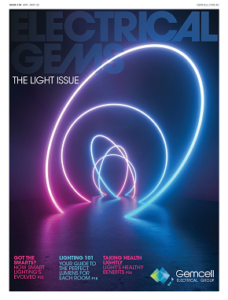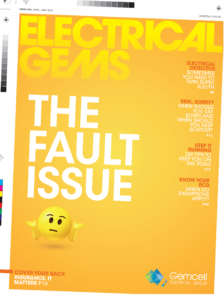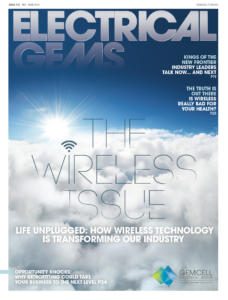Out Now
The Mental Health Issue
Current Issue
The Mental Health Issue
AUG - SEPT 2025

Silicosis is a real and present danger on many worksites. Colin Gibson, HSE manager at Master Electricians Australia, explains what this means to you.
Silica is a naturally occurring material found in quartz, rock and sand and, as such, is a key component of many building materials. Dusts generated from working with materials containing silica can penetrate deep into our lungs, causing cancers and death.
For centuries humans have been working with brick, stone and tiles, and for almost as long medical practitioners have noticed lung diseases and premature deaths among stone workers and associated trades.
In 1700, Italian Dr Bernardino Ramazzini noted evidence of disease in stone cutters, but the name silicosis wasn’t given to the condition until 1870.
The incidence of silicosis increased rapidly in the early 1900s with the advent of pneumatic hammer drills and sandblasting, and it is now becoming more common in the construction and related industries.
Respirable Crystalline Silica (RCS) is the name given to the minute dust particles that are capable of being inhaled to the deepest part of the lungs (1 to 10μm size) where they irritate the lung membranes and cause disease. As well as lung cancers, ssilicosis — an incurable condition — has also been linked to chronic bronchitis, emphysema, kidney disease and scleroderma.
Any operation involving concreting, drilling, cutting, grinding, hammering, polishing any rock/stone (manufactured or natural), concrete, ceramic and tile materials is highly likely to produce RCS dusts.
Depending on a person’s exposure, symptoms can take decades to become apparent, but include shortness of breath, chest pain, fatigue and severe cough.
The Royal Australasian College of Physicians identifies three main types of exposure:
• Chronic – at least 10 years of exposure to RCS
• Accelerated – 5 to 10 years exposure,
• Acute – exposure less than 1 year
The Australian Cancer Council estimates that in 2011, 587,000 Australian workers were exposed to silica dust on work sites, and it expects about 5758 of those to develop lung cancer as a result.
As of 01 July 2020, the Australian exposure standard for RCS was reduced to 0.05mg/m3 of air for an 8-hour time weighted shift, based on a five-day working week. If you piled this level of dust from an 8-hour shift together it would roughly cover half the area of a matchhead. When suspended in the air, this amount of dust is not visible, meaning hazardous levels of dust can be present without you knowing.
Given the vast range of uses for silica containing materials and the environments they are found in, there is no simple one-size-fits-all control method. The below are suggestions for managing RCS dusts.
• Instead of drilling into concrete once it has set, consider if it’s possible to cast fasteners or mounts into concrete as it is poured.
• Use other materials for the same task. Some manufactured stone products contain over 90% silica, whereas some concrete materials contain 25% only.
• Whenever possible, use wet cutting or dust capture systems. Wet cutting prevents dust becoming airborne; however, waste material must be cleaned up and safely disposed of before it dries and gets blown or swept away.
• Dust capture systems can be very effective but must be properly maintained.
• Dust hoods can capture all dust produced, however if you are drilling close to corners or edges, some may struggle to capture everything.
• Vacuum systems must be carefully selected to ensure they filter to the exposure standard.
• Organise jobs so your workers are not on site when other trades (i.e. tilers) are. If this is not possible, try to organise to work elsewhere on site or ‘up-wind’ of other trades.
• Very few systems are totally effective at capturing hazardous dusts, therefore respiratory protection will still be required. P2 is the minimum level required. Training workers on how to use respirators and ensure an effective seal is vital. If workers are not clean shaven, you will need to investigate positive pressure respirators.
• Consideration needs to be given to dust settling on clothes and hair, which could be dislodged and inhaled after a respirator has been taken off.
Contact Master Electricians Australia on 1300 889 198 or your professional association for information, guidance and support. Workplace Health & Safety Regulators in each state and territory also maintain resources to assist businesses manage silica dust, as does WorkSafe Australia.
Keep up to date with our latest news and competitions by subscribing to our regular newsletter.

Issue 183
OCT - NOV 2024

Issue 182
AUG - SEPT 2024

Issue 181
JUN - JUL 2024

Issue 180
APR - MAY 2024

Issue 179
FEB - MARCH 2024

Issue 178
DEC 2023 - JAN 2024

Issue 177
OCT - NOV 2023

Issue 176
AUG - SEPT 2023

Issue 175
JUN - JUL 2023

Issue 174
APR - MAY 2023

Issue 173
FEB - MAR 2023

Issue 172
DEC 2022 - JAN 2023

Issue 171
OCT - NOV 2022

Issue 170
AUG - SEPT 2022

Issue 169
JUN - JUL 2022

Issue 168
APR - MAY 2022

Issue 167
FEB - MAR 2022

Issue 166
DEC 2021 - JAN 2022

Issue 165
OCT - NOV 2021

Issue 164
AUG - SEPT 2021

Issue 163
JUN - JUL 2021

Issue 162
APR - MAY 2021

Issue 161
FEB - MAR 2021

Issue 160
DEC 2020 - JAN 2021

Issue 159
OCT - NOV 2020

Issue 158
AUG - SEPT 2020

Issue 157
JUN - JUL 2022

Issue 156
APR - MAY 2020

Issue 155
FEB - MAR 2020

Issue 154
DEC 2019 - JAN 2020

Issue 153
OCT - NOV 2019

Issue 152
AUG - SEPT 2019

Issue 151
JUN - JUL 2019

Issue 150
APR - MAY 2019

Issue 149
FEB - MAR 2019

Issue 148
DEC 2018 - JAN 2019

Issue 147
OCT - NOV 2018

Issue 146
AUG - SEPT 2018

Issue 145
JUN - JUL 2018

Issue 144
APR - MAY 2018

Issue 143
FEB - MAR 2018

Issue 142
DEC 2016 - JAN 2017

Issue 141
OCT- NOV 2017

Issue 140
AUG - SEPT 2017

Issue 139
JUN - JUL 2017

Issue 138
APR - MAY 2017

Issue 137
FEB - MAR 2017

Issue 136
DEC 2016 - JAN 2017

Issue 135
OCT - NOV 2017

Issue 134
AUG - SEPT 2016

Issue 133
JUN - JUL 2016

Issue 132
APR - MAY 2016

Issue 131
FEB - MAR 2016

Issue 130
DEC 2015 - JAN 2016

Issue 129
OCT - NOV 2015

Issue 128
AUG - SEPT 2015

Issue 127
JUN - JUL 2015

Issue 125
APR - MAY 2015

Issue 125
FEB - MAR 2015

Issue 124
DEC 2014 - JAN 2015

Issue 123
OCT - NOV 2014

Issue 122
AUG - SEPT 2014

Issue 121
JUN - JUL 2014

Issue 120
APR - MAY 2014

Issue 119
FEB - MAR 2014

Issue 118
DEC 2013 - JAN 2014

Issue 117
OCT - NOV 2013

Issue 116
AUG - SEPT 2013

Comments (0)
Write a Comment